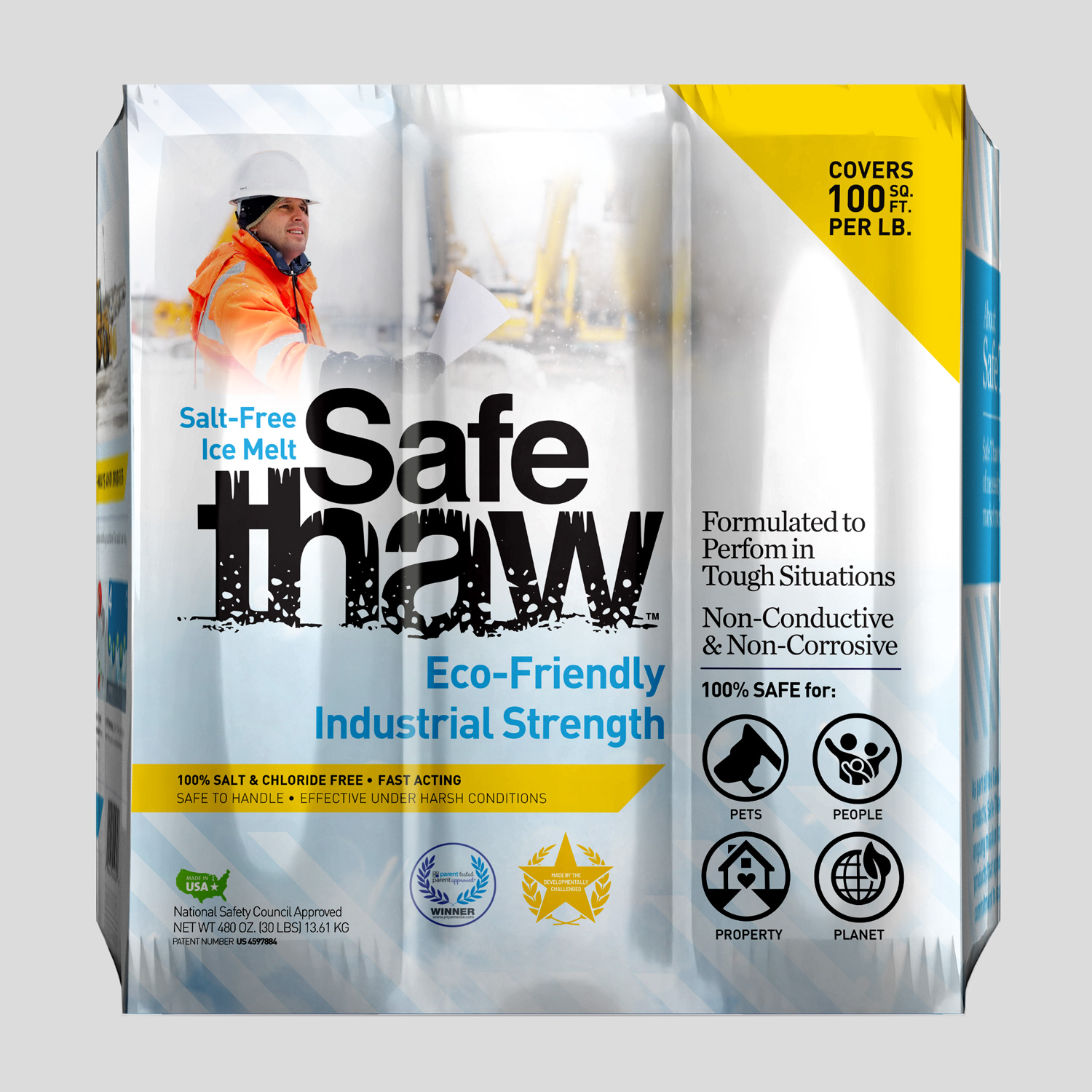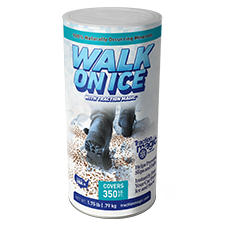Is Calcium Chloride A Winter Roof Solution?

Winter is near, and those photographic scenes of buildings covered with snow will be back, but only the property owners know the pain of managing all those bulks of ice and snow to protect their roofs. There is a range of ice melt for roofs available in the market prepared with different chemical compounds like Sodium Chloride, Calcium Chloride, Magnesium chloride, and Urea.
But it would be best to remember that the purpose of using the roof melt ice melter is not only to melt the ice but to keep the surroundings least affected and property safe. So let’s understand more about secure roof ice melt solutions.
Calcium Chloride As Ice Melt For Roofs
Calcium chloride with the chemical formula CaCl2 is a white crystalline solid widely used as ice melt. Many property owners prefer it due to its performance capacity at a low temperature of -20°F and relatively less corrosive than rock salt.
Calcium chloride is a type of salt that’s commonly used in ice melt products due to its ability to lower the freezing point of water. This means it can melt ice even in extremely cold conditions. However, while calcium chloride for ice melt is indeed effective, its application comes with certain risks.
There are products with the combination of calcium chloride in the form of tablets, which you can throw on your roof before and after the snowfall, and it will perform to break up the snowpack on the top. But how safe ice melt on the roof is it?
Given its corrosive nature, you might wonder if calcium chloride is safe for roofs. The answer is that it depends on the roofing material. While some materials might withstand it, others can get damaged over time. It’s best to seek alternatives, especially when considering what ice melt is safe for roofs.
While calcium chloride will melt ice, it can also cause damage to your roof by regular application. It will erode your roofing nails, ice dams, and shingles too. Also, calcium chloride-based ice melt for roofs can cause corrosion to aluminum siding, gutters, and fasteners.
Calcium Chloride can harm vegetation around your property; and cause dry paws, local discomfort, and gastrointestinal problems in pets of your area. In addition, its hygroscopic nature pulls moisture from hands, skin, and vegetation that can harm people, pets, and the environment.
Calcium Chloride is highly destructive to concrete and can harm the concrete through an ion-exchange process. Calcium ions from ice melt exchange place with Calcium ions in concrete. This exchange is irreversible and severely weakens and weakens and destroys concrete’s structural integrity and longevity.

Safe Thaw
Safe Thaw was created as the ice management solution for tough winter environments. Ideal in commercial and industrial properties, shops, government agencies, bridges, and construction.
Safe Thaw: A Safer Alternative To Roof Ice Melter
Recognizing the issues related to using calcium chloride to melt ice, consider Safe Thaw as an alternative. Safe Thaw is a chemical-free, toxin-free ice melt that’s safe for concrete and property. Unlike calcium chloride, Safe Thaw is safe for pets, doesn’t damage concrete or metal, and can be used safely on roofs.
Safe Thaw is a urea-modified natural product that can be used on any surface without any worries. It ensures the safety of your concrete, metal, machinery, vehicles, and environment.
It contains special surfactants that spread quickly while covering the maximum area with lesser quantity, Inhibitors that control the reformation of ice from water and give protection from cracks and corrosion, and boosters that enhance the performance to provide higher results. In addition, Safe Thaw is an eco-friendly ice melt that is entirely salt and chloride free.
Looking Beyond Calcium Chloride: Do Snow Melt System For Roof Really Solve The Problem?
While many property owners lean on calcium chloride because it seems strong enough to take on ice, others go a step further and install a snow melt system for roof. At first, it feels like an upgrade—heating cables or hydronic lines running under shingles to stop ice dams before they form. But the reality is different. These systems are costly to run, often patchy in performance, and they don’t stop heavy buildup from sliding into gutters or refreezing at the edges. It’s one more example of a “solution” that doesn’t protect the roof itself in the long term. Safe Thaw, on the other hand, works directly where the ice forms, without the ongoing expense of electricity or maintenance.
What Can You Put On A Metal Roof To Make Snow Slide Off?
That question comes up every winter. Some homeowners try oils, sprays, or even roof pucks, hoping the snow will release more easily. On a metal roof, snow tends to compact and freeze hard, making it unpredictable when it finally breaks loose. The temptation is to throw on chloride pellets or salt tablets, but all that does is stain panels, corrode fasteners, and ruin landscaping once the runoff hits the ground. Safe Thaw eliminates that guesswork. It breaks the icy bond gently, letting snow loosen without creating stains or rust streaks on your panels. It’s a safer, more predictable option than chasing after short-term fixes.
Rubber Roof Shingles And Ice Buildup
Some properties swap to rubber roof shingles because of their flexibility. They can bend without breaking and hold up better against certain freeze-thaw cycles. But that doesn’t mean they’re immune to chemical damage. Chlorides can leach into rubber, leaving marks or weakening the material over time. Safe Thaw sidesteps this risk completely—it can be applied on rubber just as confidently as on metal, asphalt, or composite surfaces. If you’ve invested in specialty roofing, it makes sense to pair it with an ice melt that won’t quietly undo your investment.
The Trouble With Salt Pucks For Roofs
Salt discs, or salt pucks for roof, look simple enough—you toss them up, they start melting channels, and water drains off. But here’s the flip side: they’re usually packed with sodium or calcium chloride. As they sit in one spot, they can create concentrated corrosion on shingles or nails, leaving behind permanent marks. Runoff kills nearby plants, and if pets track across the residue, you’ve got another safety issue. With Safe Thaw, you don’t run into any of that. Instead of worrying about “where did I throw that puck?” you can trust that every application spreads safely across the roof surface and melts ice without aftershocks.
100% salt & chloride-free, fast acting Ice Management Solution
Conclusion: A Roof-Safe Approach That Lasts
So while the options range from heated systems and sprays to rubber shingles and salt pucks, each one carries hidden risks—whether it’s high electricity bills, corrosion, staining, or harm to pets and vegetation. Safe Thaw is the outlier. Its urea-modified, chloride-free formula makes it not just safe for concrete and asphalt, but equally reliable for shingles, gutters, and roofing systems of all types.
And here’s where Safe Thaw stands out even more: it’s not only for residential use. Industrial facilities, commercial buildings, and government properties count on it precisely because it protects infrastructure while still delivering consistent ice-melting power. Whether you’re safeguarding a family home or managing a large roof system, Safe Thaw is the one solution that checks every box—performance, safety, and longevity.
FAQs
Try Also Our Other Winter Safety Products:
Safe Paw
The Original and #1 Selling Pet and Child Safe Ice Melt for over 20 years. Guaranteed environmentally safe –It won’t harm animals or children, and it won’t damage your property. That’s Safe Paw. Safe Paw can change how winter affects our planet.

Walk On Ice
The handy disposable canister can be taken everywhere, with the same 100% naturally occurring minerals that provide instant traction on ice or snow. Use it on sidewalks, steps, or as an instant traction agent for your car.



